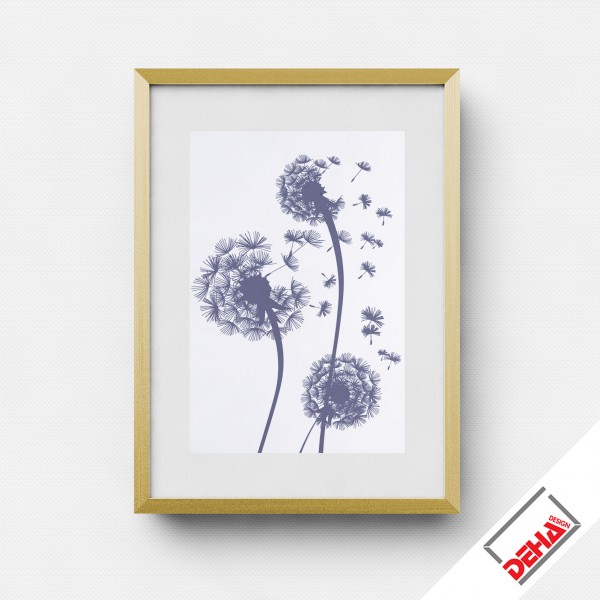Prices incl. VAT plus shipping costs
Article shipping Category: 11
Delivery time 3-5 Workdays
- Order number: SW11364
The aluminium frame Profile 2 is a contemporary picture frame with a narrow frame profile. The frame surface is anodised and available in different colours. With a clear and minimalist design the Profile 2 is perfectly suited to present modern artworks in a contemporary surrounding.
Configure the aluminium frame Profile 2 according to your wishes. You can choose between a great variety of aluminium surfaces, different frame formats and 5 different glass types.
Rotatable frame spring clips are fixed to the backing board and make sure that you can change your pictures fast and easy. Simultaneously the clips serve as hangers and make it possible to hang your frame in portrait and landscape format.
All frames are delivered with an acid-free cardboard inlay (white, 230g).
Aluminium frame Profile 2 at a glance:
• anodised aluminium finish
• choose between 5 different glass types
• acid-free cardboard inlay (white, 230g)
• solid MDF backing board with fixed spring clips
• usable for portrait and landscape format
• max. loading height: 5 mm
• solid high quality frame
| Material: | Aluminium |
| Frame Type: | Picture Frame |
| Profile Width (Frontal View): | 8 mm |
| Profile Height (Side View): | 25 mm |
| Max. Load Height: | 5 mm |
Ordinary Glass / Float Glass
In picture framing the most commonly used glass is float glass which is about 2-3mm thick, depending on the frame format. The biggest advantage of this type of glass lies in its low price, compared to the other glass types. Float glass provides protection against damage and dirt but it doesn’t prevent yellowing - especially not under direct sunlight. In addition, float glass reflects about 8 percent of light, so depending on the viewing position a mirror effect may occur.
Non-reflective Glass
Non-reflective glass has the same basic characteristics like float glass, the main difference is that it is nearly completely non-reflective due to a special manufacturing process. The glass allows just about 1% of reflections and as a result seems to be completely transparent und achieves a colour rendering of the artwork nearly true to original. For this reason, it is ideally suited for the framing of pictures that are to be presented in bright rooms. The anti-reflective effect of this glass is independent from the viewing angle and thus non-reflective glass is the ideal glazing for artworks that are highly reflective themselves (e.g. glossy prints).
Acrylic Glass Break-proof
Acrylic glass is a synthetic, glass-like art glass (PMMA). Its thickness depends on the picture format and is about 2-3mm. The advantages opposite to float glass are its low weight, especially suited for large-size framing. Moreover it is an extremely break-proof glass - it is shatterproof, flexible and rather impact-proof which is an important safety aspect regarding transportation and shipping. Acrylic glass is weatherproof and age-resistant. Highly transparent and neutral in colour this glass ensures an ideal presentation of a framed image or artwork over many years. From a conservational view acrylic glass meets highest demands. UV light is absorbed and the glass provides 99% UV protection, it is resistant to leaches and acids of medium concentration as well as resistant to petrol and oil. Caution is advised when using alcohol and benzene, never use these substances for cleaning acrylic glass since they will damage it.
Acrylic Glass Break-proof Anti-glare
This acrylic glass is a flawlessly cast art glass that is break-proof and shows maximum transparency. It shares the basic characteristics of the break-proof acrylic glass and adds a nearly non-reflective quality.
Museum Glass UV-Protection
This specialty glass is primarily used by galleries, museums or in art trade. Due to a special manufacturing process the glass is refined and enables a true to original viewing of the framed artwork. The artwork itself is protected against external influences but its appeal is not affected. The museum glass has a 98% light transparency and a very high anti-glare quality that makes it nearly invisible for the viewer. The UV 90 also protects the image from destructive sunlight and reduces about 90% of the UV light reaching the artwork. With normal glass the artworks are in danger of bleaching out, but specially manufactured UV-glass prevents this from happening and supports the longevity of the artwork.

Prices incl. VAT plus shipping costs
Article shipping Category: 1

Prices incl. VAT plus shipping costs
Article shipping Category: 1

Prices incl. VAT plus shipping costs
Article shipping Category: 1

in weiteren Varianten erhältlich
Prices incl. VAT plus shipping costs
Article shipping Category: 1

Prices incl. VAT plus shipping costs
Article shipping Category: 1





